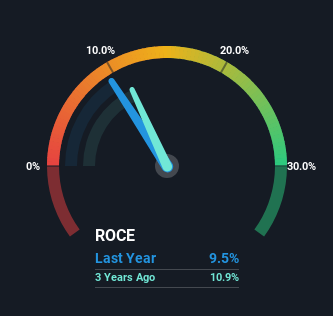- United Kingdom
- /
- Basic Materials
- /
- LSE:RHIM
Investors Met With Slowing Returns on Capital At RHI Magnesita (LON:RHIM)
What trends should we look for it we want to identify stocks that can multiply in value over the long term? In a perfect world, we'd like to see a company investing more capital into its business and ideally the returns earned from that capital are also increasing. This shows us that it's a compounding machine, able to continually reinvest its earnings back into the business and generate higher returns. Although, when we looked at RHI Magnesita (LON:RHIM), it didn't seem to tick all of these boxes.
What Is Return On Capital Employed (ROCE)?
For those who don't know, ROCE is a measure of a company's yearly pre-tax profit (its return), relative to the capital employed in the business. The formula for this calculation on RHI Magnesita is:
Return on Capital Employed = Earnings Before Interest and Tax (EBIT) ÷ (Total Assets - Current Liabilities)
0.095 = €346m ÷ (€4.8b - €1.2b) (Based on the trailing twelve months to June 2023).
So, RHI Magnesita has an ROCE of 9.5%. In absolute terms, that's a low return but it's around the Basic Materials industry average of 11%.
See our latest analysis for RHI Magnesita

In the above chart we have measured RHI Magnesita's prior ROCE against its prior performance, but the future is arguably more important. If you'd like, you can check out the forecasts from the analysts covering RHI Magnesita here for free.
So How Is RHI Magnesita's ROCE Trending?
There are better returns on capital out there than what we're seeing at RHI Magnesita. The company has consistently earned 9.5% for the last five years, and the capital employed within the business has risen 55% in that time. This poor ROCE doesn't inspire confidence right now, and with the increase in capital employed, it's evident that the business isn't deploying the funds into high return investments.
The Key Takeaway
In conclusion, RHI Magnesita has been investing more capital into the business, but returns on that capital haven't increased. Since the stock has declined 28% over the last five years, investors may not be too optimistic on this trend improving either. In any case, the stock doesn't have these traits of a multi-bagger discussed above, so if that's what you're looking for, we think you'd have more luck elsewhere.
If you want to continue researching RHI Magnesita, you might be interested to know about the 4 warning signs that our analysis has discovered.
While RHI Magnesita isn't earning the highest return, check out this free list of companies that are earning high returns on equity with solid balance sheets.
New: AI Stock Screener & Alerts
Our new AI Stock Screener scans the market every day to uncover opportunities.
• Dividend Powerhouses (3%+ Yield)
• Undervalued Small Caps with Insider Buying
• High growth Tech and AI Companies
Or build your own from over 50 metrics.
Have feedback on this article? Concerned about the content? Get in touch with us directly. Alternatively, email editorial-team (at) simplywallst.com.
This article by Simply Wall St is general in nature. We provide commentary based on historical data and analyst forecasts only using an unbiased methodology and our articles are not intended to be financial advice. It does not constitute a recommendation to buy or sell any stock, and does not take account of your objectives, or your financial situation. We aim to bring you long-term focused analysis driven by fundamental data. Note that our analysis may not factor in the latest price-sensitive company announcements or qualitative material. Simply Wall St has no position in any stocks mentioned.
About LSE:RHIM
RHI Magnesita
Develops, produces, sells, installs, and maintains refractory products and systems used in industrial high-temperature processes worldwide.
Slight risk and fair value.
Similar Companies
Market Insights
Community Narratives


Recently Updated Narratives


Alphabet: The Under-appreciated Compounder Hiding in Plain Sight


MINISO's fair value is projected at 26.69 with an anticipated PE ratio shift of 20x


The Quiet Giant That Became AI’s Power Grid
Popular Narratives


The company that turned a verb into a global necessity and basically runs the modern internet, digital ads, smartphones, maps, and AI.


MicroVision will explode future revenue by 380.37% with a vision towards success



